LAW10004 Business Law Assignment: Analyzing Contractual Issues
VerifiedAdded on 2023/06/04
|9
|1979
|118
Case Study
AI Summary
This assignment provides a detailed analysis of two distinct legal scenarios under contract law. The first scenario examines Michelle's rights against David concerning the sale of veterinary equipment, focusing on offer, acceptance, postal rules, and revocation. It concludes that a valid contract was formed, entitling Michelle to remedies for breach of contract. The second scenario assesses Jeremy's remedies against One Stop Shop regarding faulty goods and an exclusion clause. Applying relevant case law, it determines the exclusion clause to be invalid, allowing Jeremy to pursue legal action for his losses. The document includes references to relevant case law and legal resources.

Business Law Assignment
Running Head: BUSINESS AND CORPORATION LAW 0
LAW10004
Student’s Name
Running Head: BUSINESS AND CORPORATION LAW 0
LAW10004
Student’s Name
Paraphrase This Document
Need a fresh take? Get an instant paraphrase of this document with our AI Paraphraser
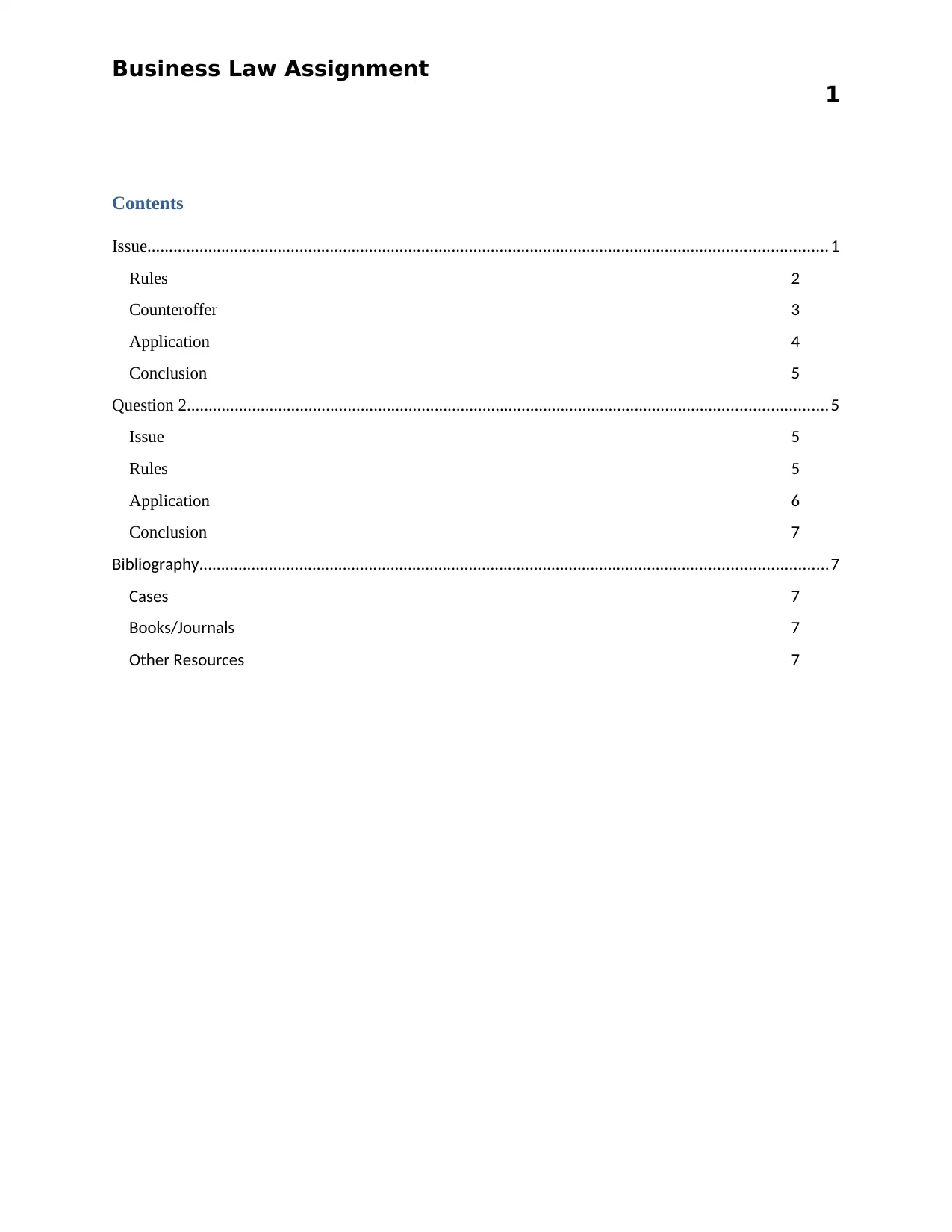
Business Law Assignment
1
Contents
Issue............................................................................................................................................................1
Rules 2
Counteroffer 3
Application 4
Conclusion 5
Question 2...................................................................................................................................................5
Issue 5
Rules 5
Application 6
Conclusion 7
Bibliography................................................................................................................................................7
Cases 7
Books/Journals 7
Other Resources 7
1
Contents
Issue............................................................................................................................................................1
Rules 2
Counteroffer 3
Application 4
Conclusion 5
Question 2...................................................................................................................................................5
Issue 5
Rules 5
Application 6
Conclusion 7
Bibliography................................................................................................................................................7
Cases 7
Books/Journals 7
Other Resources 7
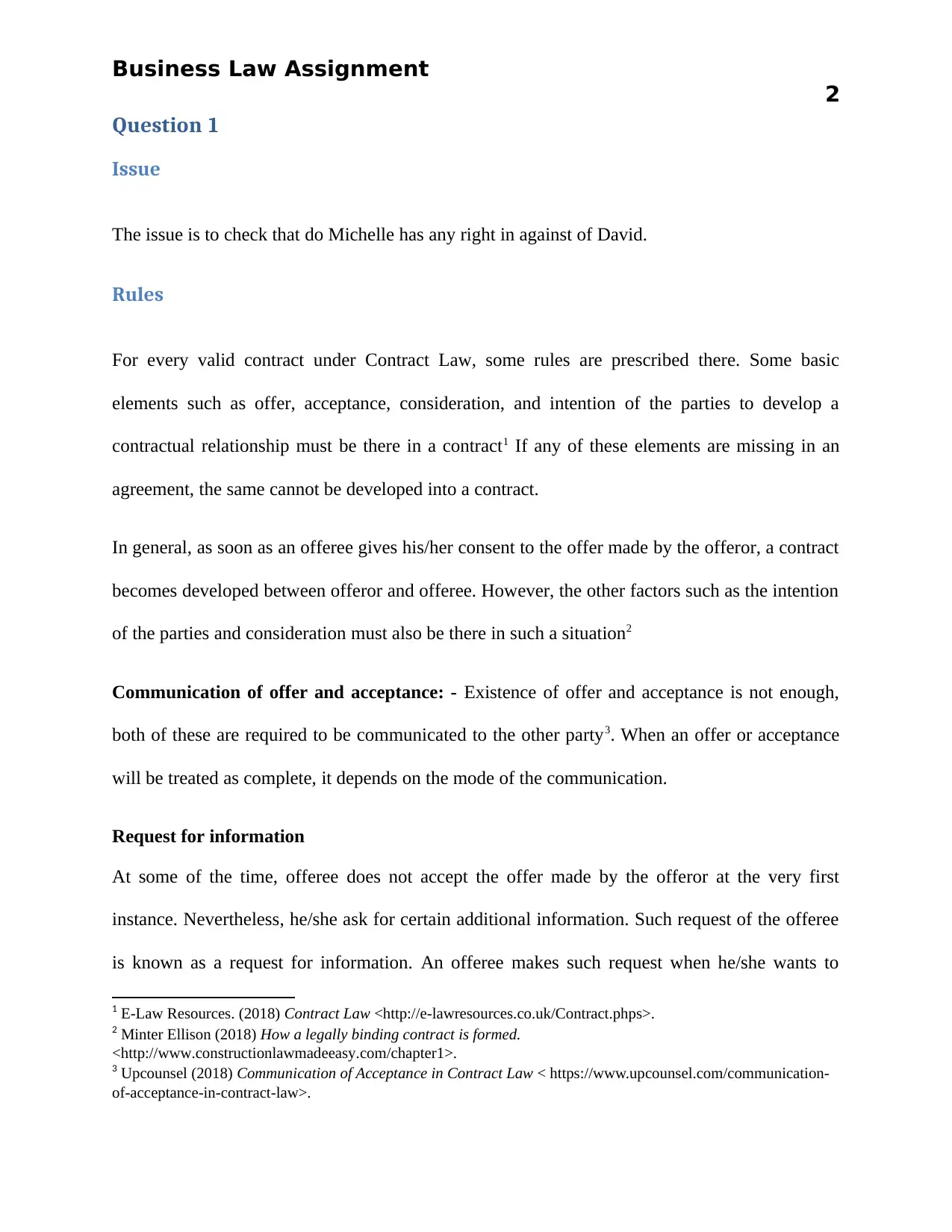
Business Law Assignment
2
Question 1
Issue
The issue is to check that do Michelle has any right in against of David.
Rules
For every valid contract under Contract Law, some rules are prescribed there. Some basic
elements such as offer, acceptance, consideration, and intention of the parties to develop a
contractual relationship must be there in a contract1 If any of these elements are missing in an
agreement, the same cannot be developed into a contract.
In general, as soon as an offeree gives his/her consent to the offer made by the offeror, a contract
becomes developed between offeror and offeree. However, the other factors such as the intention
of the parties and consideration must also be there in such a situation2
Communication of offer and acceptance: - Existence of offer and acceptance is not enough,
both of these are required to be communicated to the other party3. When an offer or acceptance
will be treated as complete, it depends on the mode of the communication.
Request for information
At some of the time, offeree does not accept the offer made by the offeror at the very first
instance. Nevertheless, he/she ask for certain additional information. Such request of the offeree
is known as a request for information. An offeree makes such request when he/she wants to
1 E-Law Resources. (2018) Contract Law <http://e-lawresources.co.uk/Contract.phps>.
2 Minter Ellison (2018) How a legally binding contract is formed.
<http://www.constructionlawmadeeasy.com/chapter1>.
3 Upcounsel (2018) Communication of Acceptance in Contract Law < https://www.upcounsel.com/communication-
of-acceptance-in-contract-law>.
2
Question 1
Issue
The issue is to check that do Michelle has any right in against of David.
Rules
For every valid contract under Contract Law, some rules are prescribed there. Some basic
elements such as offer, acceptance, consideration, and intention of the parties to develop a
contractual relationship must be there in a contract1 If any of these elements are missing in an
agreement, the same cannot be developed into a contract.
In general, as soon as an offeree gives his/her consent to the offer made by the offeror, a contract
becomes developed between offeror and offeree. However, the other factors such as the intention
of the parties and consideration must also be there in such a situation2
Communication of offer and acceptance: - Existence of offer and acceptance is not enough,
both of these are required to be communicated to the other party3. When an offer or acceptance
will be treated as complete, it depends on the mode of the communication.
Request for information
At some of the time, offeree does not accept the offer made by the offeror at the very first
instance. Nevertheless, he/she ask for certain additional information. Such request of the offeree
is known as a request for information. An offeree makes such request when he/she wants to
1 E-Law Resources. (2018) Contract Law <http://e-lawresources.co.uk/Contract.phps>.
2 Minter Ellison (2018) How a legally binding contract is formed.
<http://www.constructionlawmadeeasy.com/chapter1>.
3 Upcounsel (2018) Communication of Acceptance in Contract Law < https://www.upcounsel.com/communication-
of-acceptance-in-contract-law>.
⊘ This is a preview!⊘
Do you want full access?
Subscribe today to unlock all pages.

Trusted by 1+ million students worldwide

Business Law Assignment
3
know something more about the subject matter or any other fact related to the contract. This is
necessary to state that a request for information does not cancel out the original offer and is not
treated as an additional term. Even after making a request for information, an offeree can accept
the original offer of the offeror.
Counteroffer
A counter offer is a reply from the side of offeree in a contract where such person does not
accept the offer made by an offeror in it is original form and insert some new terms and
conditions. A counter offer is neither an acceptance nor a request for information. It was held in
the case of Hyde v Wrench4 that a counteroffer cancels all the previous offers in a contract and
the offeree cannot accept the original offer.
One must not get confused between the request for information and counteroffer. In a request for
information, the offeree does not introduce any new term but merely ask for certain additional
information.
Postal Rules: - when parties to a contract decide in mutual that they will use the postal mode for
the communication throughout the contract, then in such a situation, postal rules are applicable.
According to the decision given in the case of Adams v Lindsell5, whenever the postal rules are
applicable in a contract, an acceptance is treated completely as soon as the offeree places the
letter to the mailbox. It means if an offeree placed a letter to post as on 02 day of June and the
same been received by the offeror as on 07th day of June then acceptance will be considered as
complete as on 02nd June and not 07th June.
4 Hyde v Wrench (1840) 49 ER 132
5 Adams v Lindsell (1818) 106 ER 250
3
know something more about the subject matter or any other fact related to the contract. This is
necessary to state that a request for information does not cancel out the original offer and is not
treated as an additional term. Even after making a request for information, an offeree can accept
the original offer of the offeror.
Counteroffer
A counter offer is a reply from the side of offeree in a contract where such person does not
accept the offer made by an offeror in it is original form and insert some new terms and
conditions. A counter offer is neither an acceptance nor a request for information. It was held in
the case of Hyde v Wrench4 that a counteroffer cancels all the previous offers in a contract and
the offeree cannot accept the original offer.
One must not get confused between the request for information and counteroffer. In a request for
information, the offeree does not introduce any new term but merely ask for certain additional
information.
Postal Rules: - when parties to a contract decide in mutual that they will use the postal mode for
the communication throughout the contract, then in such a situation, postal rules are applicable.
According to the decision given in the case of Adams v Lindsell5, whenever the postal rules are
applicable in a contract, an acceptance is treated completely as soon as the offeree places the
letter to the mailbox. It means if an offeree placed a letter to post as on 02 day of June and the
same been received by the offeror as on 07th day of June then acceptance will be considered as
complete as on 02nd June and not 07th June.
4 Hyde v Wrench (1840) 49 ER 132
5 Adams v Lindsell (1818) 106 ER 250
Paraphrase This Document
Need a fresh take? Get an instant paraphrase of this document with our AI Paraphraser
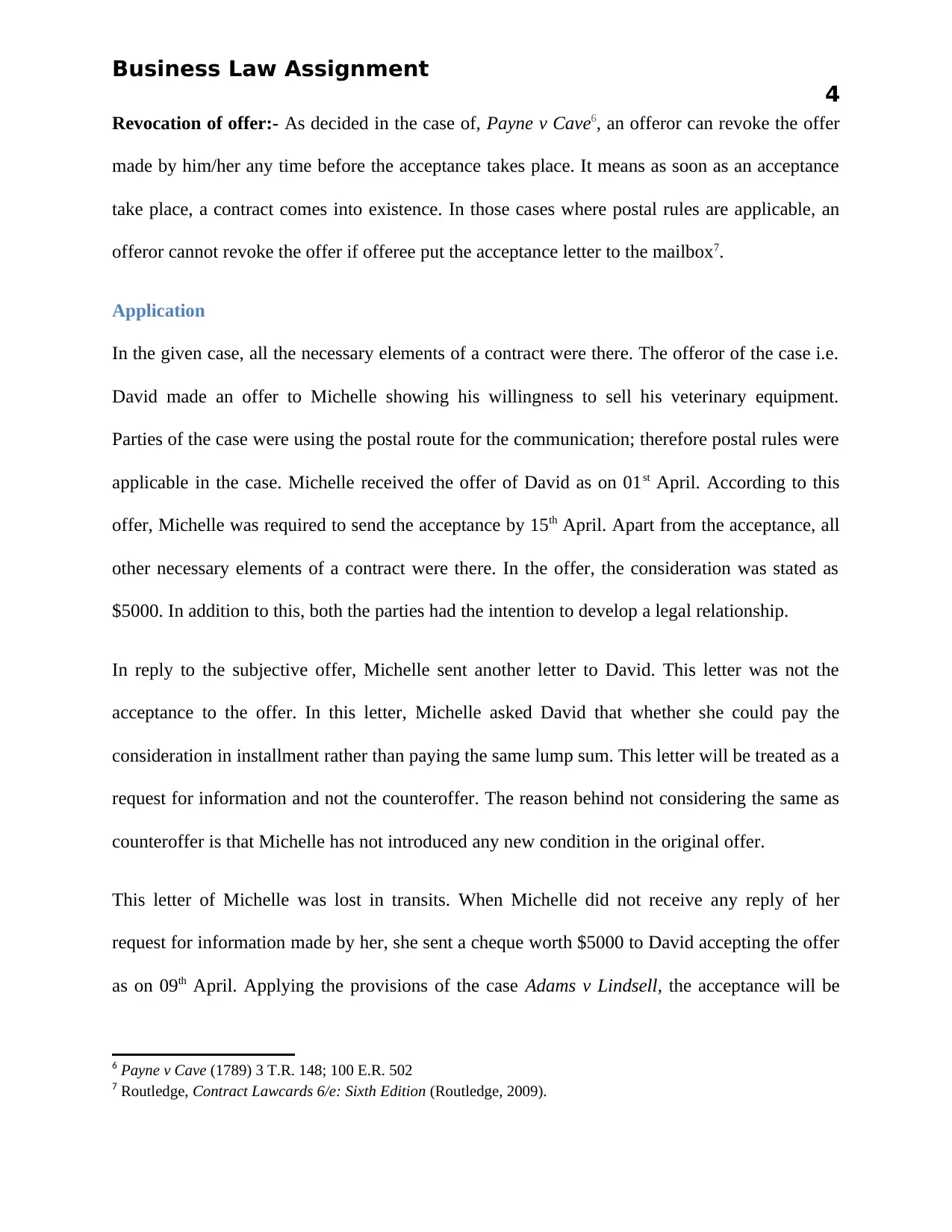
Business Law Assignment
4
Revocation of offer:- As decided in the case of, Payne v Cave6, an offeror can revoke the offer
made by him/her any time before the acceptance takes place. It means as soon as an acceptance
take place, a contract comes into existence. In those cases where postal rules are applicable, an
offeror cannot revoke the offer if offeree put the acceptance letter to the mailbox7.
Application
In the given case, all the necessary elements of a contract were there. The offeror of the case i.e.
David made an offer to Michelle showing his willingness to sell his veterinary equipment.
Parties of the case were using the postal route for the communication; therefore postal rules were
applicable in the case. Michelle received the offer of David as on 01st April. According to this
offer, Michelle was required to send the acceptance by 15th April. Apart from the acceptance, all
other necessary elements of a contract were there. In the offer, the consideration was stated as
$5000. In addition to this, both the parties had the intention to develop a legal relationship.
In reply to the subjective offer, Michelle sent another letter to David. This letter was not the
acceptance to the offer. In this letter, Michelle asked David that whether she could pay the
consideration in installment rather than paying the same lump sum. This letter will be treated as a
request for information and not the counteroffer. The reason behind not considering the same as
counteroffer is that Michelle has not introduced any new condition in the original offer.
This letter of Michelle was lost in transits. When Michelle did not receive any reply of her
request for information made by her, she sent a cheque worth $5000 to David accepting the offer
as on 09th April. Applying the provisions of the case Adams v Lindsell, the acceptance will be
6 Payne v Cave (1789) 3 T.R. 148; 100 E.R. 502
7 Routledge, Contract Lawcards 6/e: Sixth Edition (Routledge, 2009).
4
Revocation of offer:- As decided in the case of, Payne v Cave6, an offeror can revoke the offer
made by him/her any time before the acceptance takes place. It means as soon as an acceptance
take place, a contract comes into existence. In those cases where postal rules are applicable, an
offeror cannot revoke the offer if offeree put the acceptance letter to the mailbox7.
Application
In the given case, all the necessary elements of a contract were there. The offeror of the case i.e.
David made an offer to Michelle showing his willingness to sell his veterinary equipment.
Parties of the case were using the postal route for the communication; therefore postal rules were
applicable in the case. Michelle received the offer of David as on 01st April. According to this
offer, Michelle was required to send the acceptance by 15th April. Apart from the acceptance, all
other necessary elements of a contract were there. In the offer, the consideration was stated as
$5000. In addition to this, both the parties had the intention to develop a legal relationship.
In reply to the subjective offer, Michelle sent another letter to David. This letter was not the
acceptance to the offer. In this letter, Michelle asked David that whether she could pay the
consideration in installment rather than paying the same lump sum. This letter will be treated as a
request for information and not the counteroffer. The reason behind not considering the same as
counteroffer is that Michelle has not introduced any new condition in the original offer.
This letter of Michelle was lost in transits. When Michelle did not receive any reply of her
request for information made by her, she sent a cheque worth $5000 to David accepting the offer
as on 09th April. Applying the provisions of the case Adams v Lindsell, the acceptance will be
6 Payne v Cave (1789) 3 T.R. 148; 100 E.R. 502
7 Routledge, Contract Lawcards 6/e: Sixth Edition (Routledge, 2009).
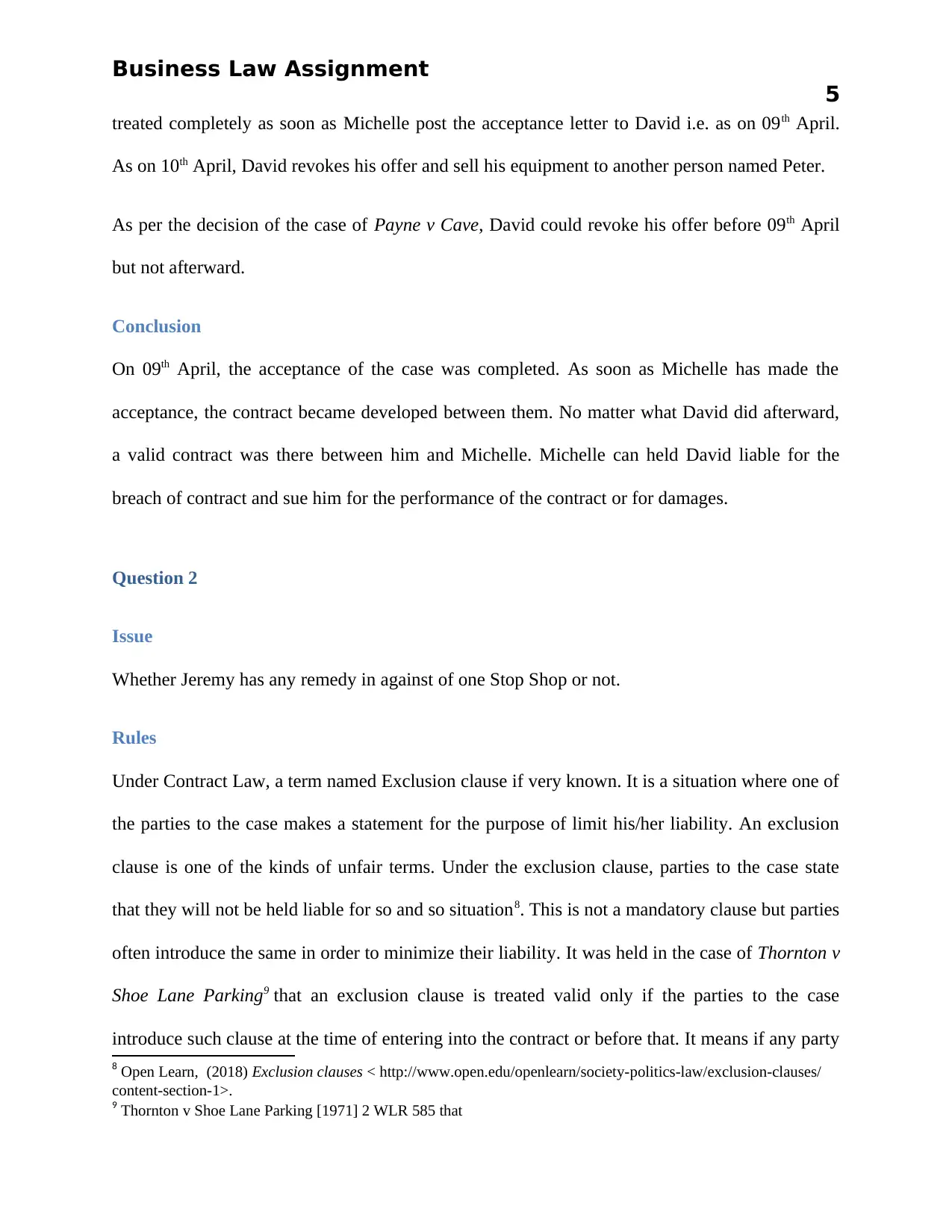
Business Law Assignment
5
treated completely as soon as Michelle post the acceptance letter to David i.e. as on 09th April.
As on 10th April, David revokes his offer and sell his equipment to another person named Peter.
As per the decision of the case of Payne v Cave, David could revoke his offer before 09th April
but not afterward.
Conclusion
On 09th April, the acceptance of the case was completed. As soon as Michelle has made the
acceptance, the contract became developed between them. No matter what David did afterward,
a valid contract was there between him and Michelle. Michelle can held David liable for the
breach of contract and sue him for the performance of the contract or for damages.
Question 2
Issue
Whether Jeremy has any remedy in against of one Stop Shop or not.
Rules
Under Contract Law, a term named Exclusion clause if very known. It is a situation where one of
the parties to the case makes a statement for the purpose of limit his/her liability. An exclusion
clause is one of the kinds of unfair terms. Under the exclusion clause, parties to the case state
that they will not be held liable for so and so situation8. This is not a mandatory clause but parties
often introduce the same in order to minimize their liability. It was held in the case of Thornton v
Shoe Lane Parking9 that an exclusion clause is treated valid only if the parties to the case
introduce such clause at the time of entering into the contract or before that. It means if any party
8 Open Learn, (2018) Exclusion clauses < http://www.open.edu/openlearn/society-politics-law/exclusion-clauses/
content-section-1>.
9 Thornton v Shoe Lane Parking [1971] 2 WLR 585 that
5
treated completely as soon as Michelle post the acceptance letter to David i.e. as on 09th April.
As on 10th April, David revokes his offer and sell his equipment to another person named Peter.
As per the decision of the case of Payne v Cave, David could revoke his offer before 09th April
but not afterward.
Conclusion
On 09th April, the acceptance of the case was completed. As soon as Michelle has made the
acceptance, the contract became developed between them. No matter what David did afterward,
a valid contract was there between him and Michelle. Michelle can held David liable for the
breach of contract and sue him for the performance of the contract or for damages.
Question 2
Issue
Whether Jeremy has any remedy in against of one Stop Shop or not.
Rules
Under Contract Law, a term named Exclusion clause if very known. It is a situation where one of
the parties to the case makes a statement for the purpose of limit his/her liability. An exclusion
clause is one of the kinds of unfair terms. Under the exclusion clause, parties to the case state
that they will not be held liable for so and so situation8. This is not a mandatory clause but parties
often introduce the same in order to minimize their liability. It was held in the case of Thornton v
Shoe Lane Parking9 that an exclusion clause is treated valid only if the parties to the case
introduce such clause at the time of entering into the contract or before that. It means if any party
8 Open Learn, (2018) Exclusion clauses < http://www.open.edu/openlearn/society-politics-law/exclusion-clauses/
content-section-1>.
9 Thornton v Shoe Lane Parking [1971] 2 WLR 585 that
⊘ This is a preview!⊘
Do you want full access?
Subscribe today to unlock all pages.

Trusted by 1+ million students worldwide
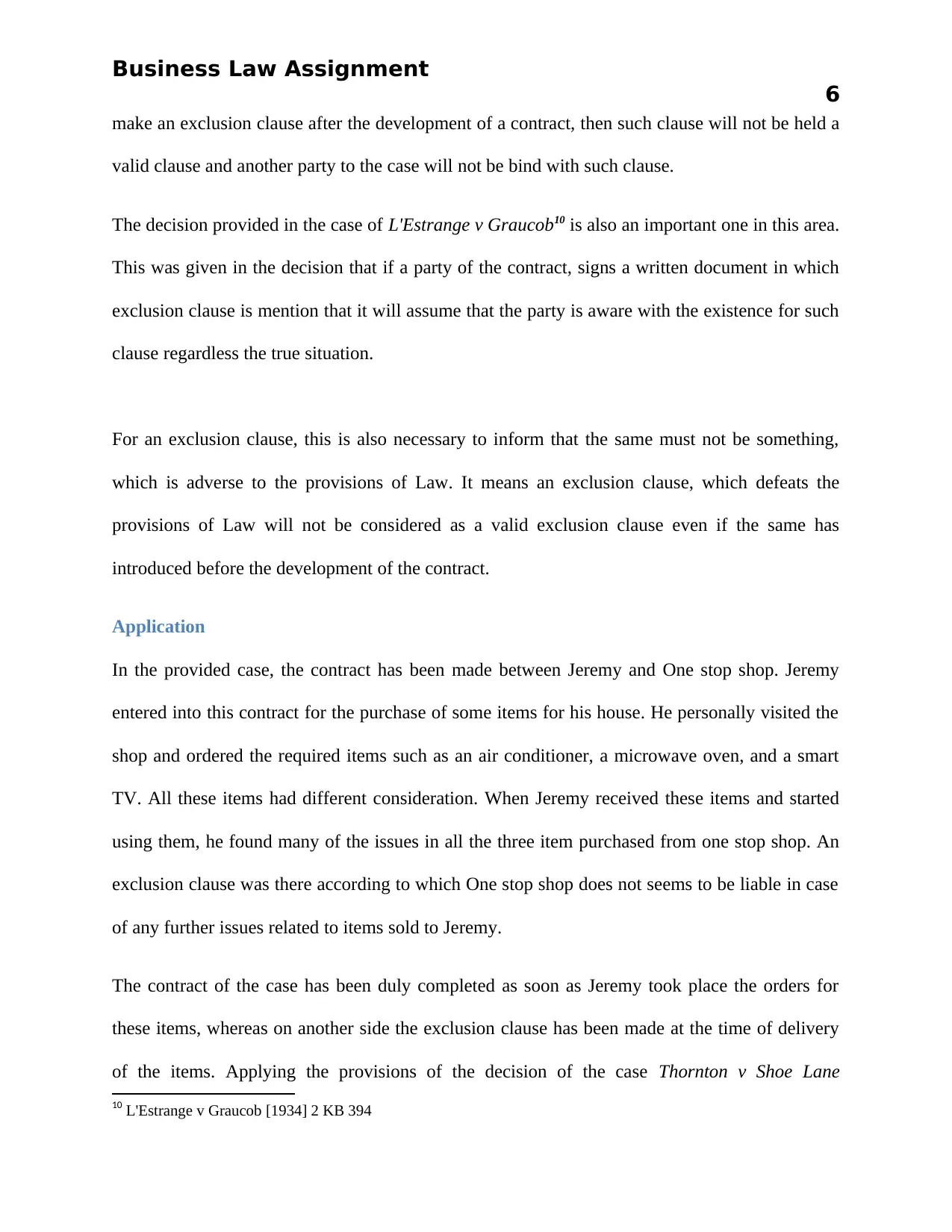
Business Law Assignment
6
make an exclusion clause after the development of a contract, then such clause will not be held a
valid clause and another party to the case will not be bind with such clause.
The decision provided in the case of L'Estrange v Graucob10 is also an important one in this area.
This was given in the decision that if a party of the contract, signs a written document in which
exclusion clause is mention that it will assume that the party is aware with the existence for such
clause regardless the true situation.
For an exclusion clause, this is also necessary to inform that the same must not be something,
which is adverse to the provisions of Law. It means an exclusion clause, which defeats the
provisions of Law will not be considered as a valid exclusion clause even if the same has
introduced before the development of the contract.
Application
In the provided case, the contract has been made between Jeremy and One stop shop. Jeremy
entered into this contract for the purchase of some items for his house. He personally visited the
shop and ordered the required items such as an air conditioner, a microwave oven, and a smart
TV. All these items had different consideration. When Jeremy received these items and started
using them, he found many of the issues in all the three item purchased from one stop shop. An
exclusion clause was there according to which One stop shop does not seems to be liable in case
of any further issues related to items sold to Jeremy.
The contract of the case has been duly completed as soon as Jeremy took place the orders for
these items, whereas on another side the exclusion clause has been made at the time of delivery
of the items. Applying the provisions of the decision of the case Thornton v Shoe Lane
10 L'Estrange v Graucob [1934] 2 KB 394
6
make an exclusion clause after the development of a contract, then such clause will not be held a
valid clause and another party to the case will not be bind with such clause.
The decision provided in the case of L'Estrange v Graucob10 is also an important one in this area.
This was given in the decision that if a party of the contract, signs a written document in which
exclusion clause is mention that it will assume that the party is aware with the existence for such
clause regardless the true situation.
For an exclusion clause, this is also necessary to inform that the same must not be something,
which is adverse to the provisions of Law. It means an exclusion clause, which defeats the
provisions of Law will not be considered as a valid exclusion clause even if the same has
introduced before the development of the contract.
Application
In the provided case, the contract has been made between Jeremy and One stop shop. Jeremy
entered into this contract for the purchase of some items for his house. He personally visited the
shop and ordered the required items such as an air conditioner, a microwave oven, and a smart
TV. All these items had different consideration. When Jeremy received these items and started
using them, he found many of the issues in all the three item purchased from one stop shop. An
exclusion clause was there according to which One stop shop does not seems to be liable in case
of any further issues related to items sold to Jeremy.
The contract of the case has been duly completed as soon as Jeremy took place the orders for
these items, whereas on another side the exclusion clause has been made at the time of delivery
of the items. Applying the provisions of the decision of the case Thornton v Shoe Lane
10 L'Estrange v Graucob [1934] 2 KB 394
Paraphrase This Document
Need a fresh take? Get an instant paraphrase of this document with our AI Paraphraser
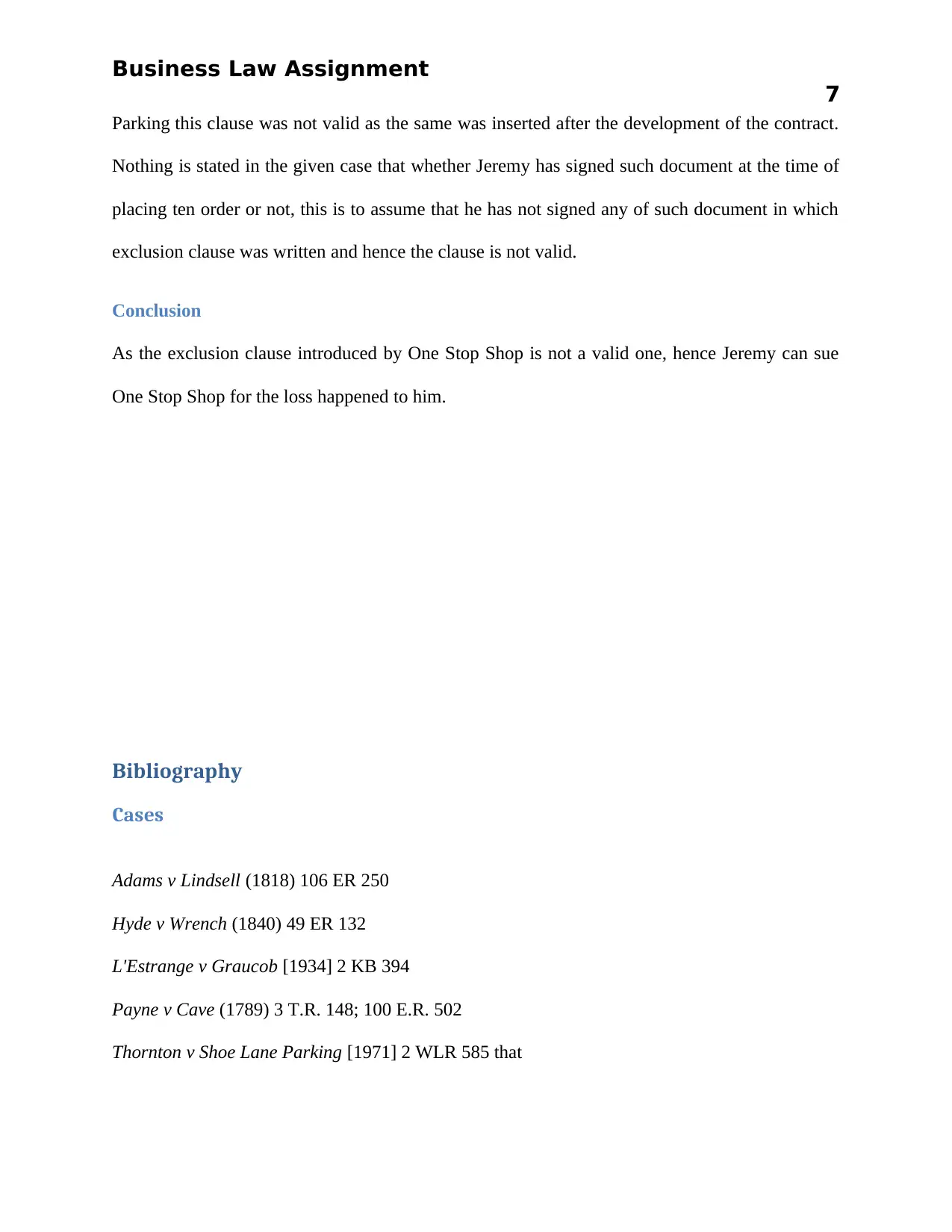
Business Law Assignment
7
Parking this clause was not valid as the same was inserted after the development of the contract.
Nothing is stated in the given case that whether Jeremy has signed such document at the time of
placing ten order or not, this is to assume that he has not signed any of such document in which
exclusion clause was written and hence the clause is not valid.
Conclusion
As the exclusion clause introduced by One Stop Shop is not a valid one, hence Jeremy can sue
One Stop Shop for the loss happened to him.
Bibliography
Cases
Adams v Lindsell (1818) 106 ER 250
Hyde v Wrench (1840) 49 ER 132
L'Estrange v Graucob [1934] 2 KB 394
Payne v Cave (1789) 3 T.R. 148; 100 E.R. 502
Thornton v Shoe Lane Parking [1971] 2 WLR 585 that
7
Parking this clause was not valid as the same was inserted after the development of the contract.
Nothing is stated in the given case that whether Jeremy has signed such document at the time of
placing ten order or not, this is to assume that he has not signed any of such document in which
exclusion clause was written and hence the clause is not valid.
Conclusion
As the exclusion clause introduced by One Stop Shop is not a valid one, hence Jeremy can sue
One Stop Shop for the loss happened to him.
Bibliography
Cases
Adams v Lindsell (1818) 106 ER 250
Hyde v Wrench (1840) 49 ER 132
L'Estrange v Graucob [1934] 2 KB 394
Payne v Cave (1789) 3 T.R. 148; 100 E.R. 502
Thornton v Shoe Lane Parking [1971] 2 WLR 585 that
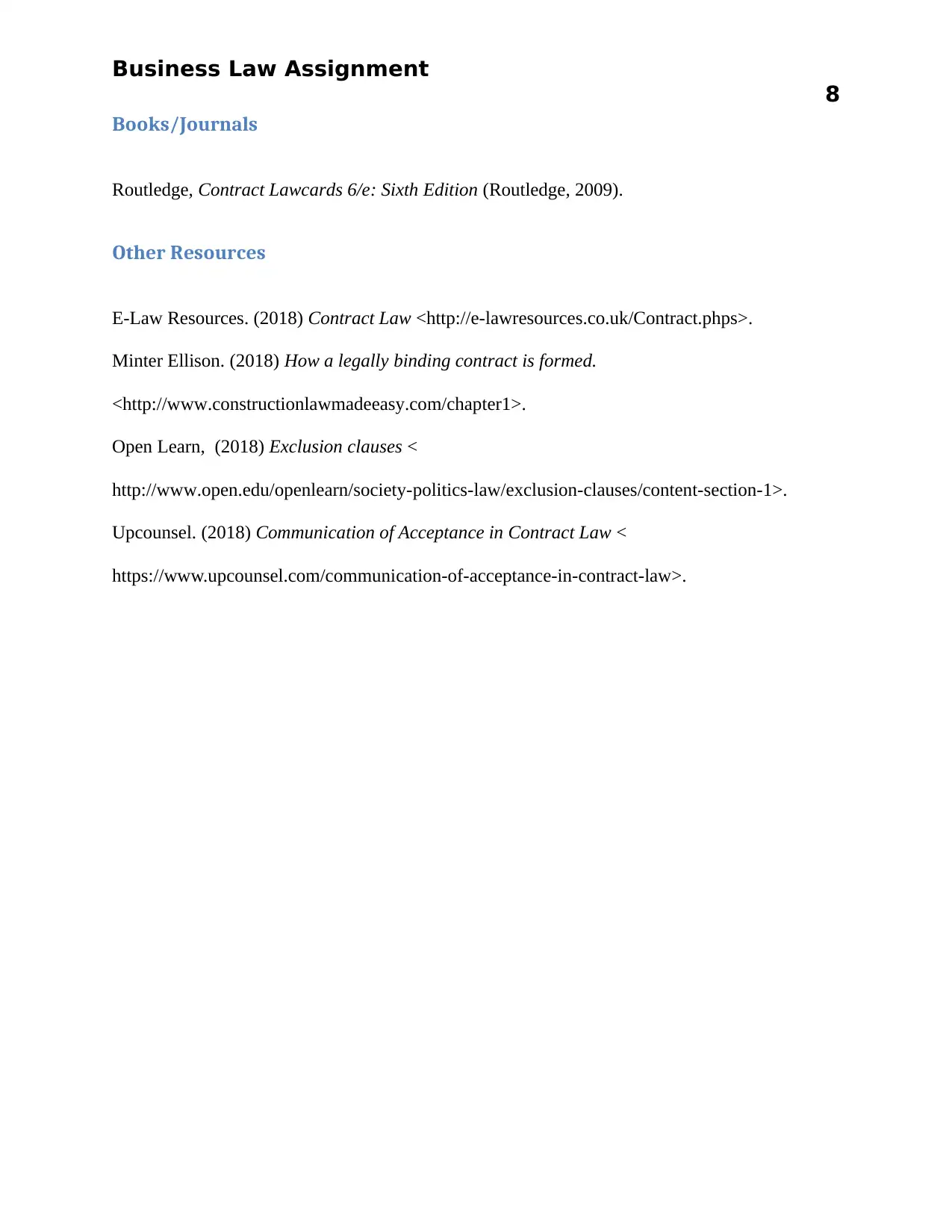
Business Law Assignment
8
Books/Journals
Routledge, Contract Lawcards 6/e: Sixth Edition (Routledge, 2009).
Other Resources
E-Law Resources. (2018) Contract Law <http://e-lawresources.co.uk/Contract.phps>.
Minter Ellison. (2018) How a legally binding contract is formed.
<http://www.constructionlawmadeeasy.com/chapter1>.
Open Learn, (2018) Exclusion clauses <
http://www.open.edu/openlearn/society-politics-law/exclusion-clauses/content-section-1>.
Upcounsel. (2018) Communication of Acceptance in Contract Law <
https://www.upcounsel.com/communication-of-acceptance-in-contract-law>.
8
Books/Journals
Routledge, Contract Lawcards 6/e: Sixth Edition (Routledge, 2009).
Other Resources
E-Law Resources. (2018) Contract Law <http://e-lawresources.co.uk/Contract.phps>.
Minter Ellison. (2018) How a legally binding contract is formed.
<http://www.constructionlawmadeeasy.com/chapter1>.
Open Learn, (2018) Exclusion clauses <
http://www.open.edu/openlearn/society-politics-law/exclusion-clauses/content-section-1>.
Upcounsel. (2018) Communication of Acceptance in Contract Law <
https://www.upcounsel.com/communication-of-acceptance-in-contract-law>.
⊘ This is a preview!⊘
Do you want full access?
Subscribe today to unlock all pages.

Trusted by 1+ million students worldwide
1 out of 9
Related Documents
Your All-in-One AI-Powered Toolkit for Academic Success.
+13062052269
info@desklib.com
Available 24*7 on WhatsApp / Email
![[object Object]](/_next/static/media/star-bottom.7253800d.svg)
Unlock your academic potential
Copyright © 2020–2025 A2Z Services. All Rights Reserved. Developed and managed by ZUCOL.



